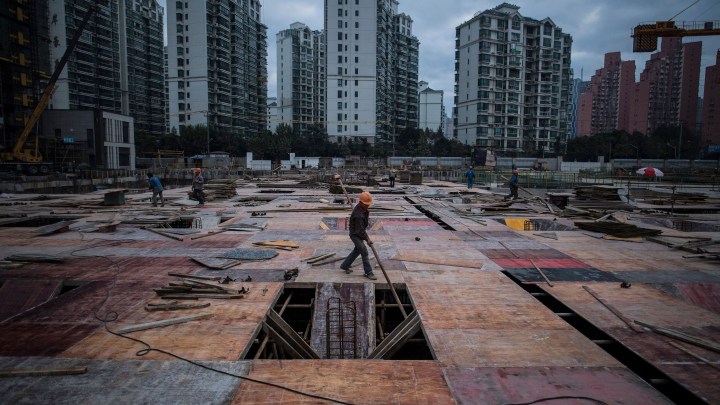
China’s local government debt burden weighs on investment

There’s a fear right now that China’s economy is in worse shape than previously thought. Recently, key data on Chinese manufacturing, retail sales and investment have all come in weaker than expected. The country is not bouncing back from strict zero-COVID policies as strongly as predicted. And all of this is wrapped up in a pile of debt that local governments are facing.
The problem is that China has historically relied on local government investment to stimulate the economy, and that strategy is running out of steam.
Logan Wright, a partner at Rhodium Group, a research and policy consulting shop, watches this issue carefully. He spoke about it with “Marketplace Morning Report” host Sabri Ben-Achour. The following is an edited transcript of their conversation.
Sabri Ben-Achour: So here in the U.S., when we think about the government stimulating or supporting the economy, we think about the federal COVID relief or federal stimulus — it comes from the national government. In China, it is not quite like that. Can you explain how it works?
Logan Wright: When China tries to use fiscal policy countercyclically to stimulate growth, they typically do it not through direct budget allocations in which the central government puts money in people’s pockets, but through investment that is funded largely by local governments. And because local governments can’t borrow directly, except through some very narrow channels, they use these indirect forms of borrowing through local government financing vehicles, these sort of separate companies. They usually are based on business that involves building projects and then selling them back to local governments or other local state-owned enterprises. But the point is, it’s not done directly through a budgetary transfer. And, as a result, you can end up seeing much more local government investment than the government anticipated, which is sort of what happened after the global financial crisis.
Ben-Achour: In the U.S., for many years, there was sort of a stigma associated with supporting one industry over another. I mean, we obviously still did it from time to time. But in China, it’s kind of a different ballgame. So what kind of support does the government, through the local governments, offer to business and industry?
Wright: Typically, the way the Chinese government controls the economy more broadly is through the allocation of credit, and so control over the financial system to direct credit through state-owned enterprises. And then through quasi-fiscal kind of lending through local government vehicles. So often what is involved is the presentation of project plans, like infrastructure project plans. There’s approval of those plans, then there’s a funding mechanism for those to be executed.
And so in some cases, you’ll get direct subsidies for certain industries. But by and large, the focus of policy stimulus in China has been to deliver growth, employment, investment through either infrastructure — construction of large transport, water treatment, railways, all sorts of different infrastructure concepts that have been deployed over the years. Or indirectly encouraging other forms of construction, like the property sector. So Beijing has had a very on-again, off-again relationship with hoarding property-sector growth over several years. In recent years, they tried to discourage it because growth was so excessive in property construction. But, historically, that has also been one of the key drivers of investment growth throughout China’s economy and something that they have relied upon by cutting mortgage rates, by encouraging home purchases by residents in different cities, for example. That’s one of the mechanisms they used to prop up the economy in the past.
Ben-Achour: So we have all of this investment in infrastructure, in property through local governments, and those local governments are in debt. How badly are they in debt?
Wright: Right. So the point is that this local government borrowing was never really designed to be — and these local government infrastructure projects were never really designed — to pay off bank loans that were made at commercial terms. A lot of these are for schools or hospitals or public goods. And so therefore, the entire model that was used to fund them always had an implicit backstop, that somewhere down the line, the central government was going to come in and either transfer fiscal resources to local governments to repay the debt or to basically assume the debt.
Well, that moment is here, precisely because it has become too difficult, given the volume of local government debt, for them to continue funding investment at the same rates as they’ve had in the past. So it is a reasonable estimate that total local government debt is roughly around China’s [gross domestic product] — you know, roughly around 100% of GDP, or around $16 trillion or $17 trillion in total. And so about half of that is held by so-called local government financing vehicles. So these are supposed to be separate companies that are indirectly owned by local governments, and local governments have an implicit obligation to back them, and none of them have ever defaulted.
But this is a very large volume of debt. So if any of them ever do default, it raises an immediate question of, is Beijing going to actually step in and support all of those companies? Are they going to support some of them? Are they going to support only those in certain cities or provinces? Are they going to support only those in certain industries or who fund different types of projects? Those are the questions that are now being asked.
And the reason being is that because, again, these projects, the average return on all of these projects is closer to 1% in pure financial terms, if you look at averages or median levels across local government financing vehicles. Their interest costs are much higher, closer to 5.5%. So this isn’t a sustainable model. And Beijing is now under pressure to make it more sustainable.
Ben-Achour: If Beijing is now possibly on the hook for all this local government debt, how does that connect with the economic malaise that the country finds itself in right now?
Wright: Right. In many ways, the property market crisis in China and the local government crisis are the same crisis. And they’re very much linked. They are a problem of, you cannot continue funding the same pace of investment, whether that is in property or infrastructure, because you do not have a financial system that can continue expanding at the same rates as it has in the past. China’s banking system is around two, two and a half times the size of the U.S. banking system in total assets. It’s not a completely fair comparison because the U.S. has a more diversified financial system. China has a more bank-centric financial system. But the point is, in a banking system that has a little bit over half of global GDP in assets, it’s very hard to keep it growing at the rates that they saw in the past, closer to 15% to 17% over the previous decade. Now it’s growing, it’s roughly 9% to 10%, in terms of credit. So you can’t keep funding the same pace of investment in the future, which means that if investment has been a critical driver of China’s growth — it’s about 42% of the economy at this point — that’s going to slow down, and therefore overall economic growth is going to slow down.
And that slowdown is not cyclical, but structural. You cannot repeat the same drivers of growth as you have seen in the recent past. And so, in many ways, the structural slowdown that China is facing, we are seeing a much sharper break with past rates of economic performance, relative to what you saw over the previous decade. And the fact that you can’t rely upon property and infrastructure investment is one of the key reasons for that.
Ben-Achour: So if I’m to understand correctly, it is as if the local governments in China have had their foot on the gas for many years in terms of the economy. And so if the national government now wants to step in to support an ailing economy, there’s not much more pedal to push.
Wright: Right, and the whole point is that you’ve already been running very large fiscal deficits — and China’s fiscal deficits, including local and central governments, have averaged around 6% of GDP in recent years. That doesn’t prevent you from financing those deficits internally. You can do that. But it does make it a lot more difficult to generate marginal growth from those levels of spending because you’re already committed so strongly to local government investment at very high levels.
And so if you’re going to manage the debt problem — and this is where I think it’s a little less understood — to say that you’re going to manage China’s local government debt problem is implicitly a statement that China is going to rebalance the economy and is going to be less dependent upon investment-led growth in the future. Rebalancing the economy is a very difficult prospect. It probably involves slower growth in investment in the short term, hoping for more sustainable growth that is consumption led in the medium term. But there’s no guarantee that that happens at the same rates as what we’ve seen in the past, which is why this is such a momentous decision. And the fact that Beijing is really at the end of a previous road, in terms of how to support the economy, is so meaningful.
Ben-Achour: They can’t get out of this economic doldrum by writing more checks. Something structural is going to have to change?
Wright: You can’t do it through the same mechanisms as you have been using over the past decade to support growth. So Beijing is going to need different tactics to put money in people’s pockets, to support household consumption, to somehow transfer state resources to households in some respect, but those are longer-term, more difficult political questions, to enable faster consumption-led growth. What is obvious is that you can’t maintain the same pace of credit and investment growth as you have in the past because you are already facing problems in how that investment is being financed at this stage. And the debt levels — if you just continue trying to use the same driver, you’re just going to get much less bang for your buck in terms of trying to deliver additional investment-led growth. You’re not only not going to see the improvement in productivity that will come from more productive investments in the economy, but you’re not even going to see much of that investment get off the ground because the mechanisms you’re using to stimulate growth are using a lot of those proceeds to repay debt as well as fund new spending.
There’s a lot happening in the world. Through it all, Marketplace is here for you.
You rely on Marketplace to break down the world’s events and tell you how it affects you in a fact-based, approachable way. We rely on your financial support to keep making that possible.
Your donation today powers the independent journalism that you rely on. For just $5/month, you can help sustain Marketplace so we can keep reporting on the things that matter to you.

















